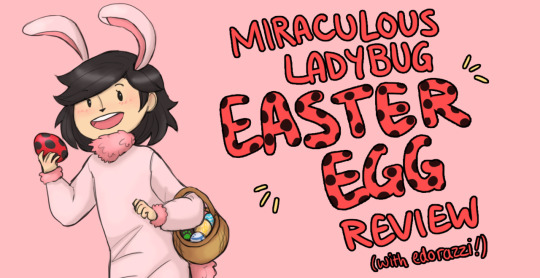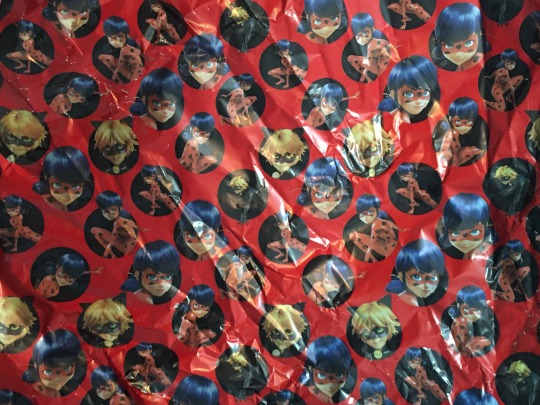#the true meaning of easter is MIRACULOUS CHOCOLATE and we all KNOW this
Text

After the saga of the month-long Miraculous Christmas calendar review, it feels right to come back for round two with an Easter-themed treat!
(The alternative title is I Really Wanted The ML Easter Egg And Figured I Could Justify Buying It For Review Purposes, but thats a bit of a mouthful.)
I bought this from Amazon UK for £14.90 - you can find the listing for yourself here, but it’s currently out of stock! I guess I picked it up at the right time.

On opening the box, I’m already seeing shards of chocolate. I suppose that means the egg is a goner. I think I’m gonna have to complain about that - trying to ship a fragile chocolate egg is tricky enough (I was prepared for some damage, what can ya do), but it was crammed into a very small box with no extra padding to at least attempt preserving it.
I don’t mind too much, but for almost £15 I think I deserve something that actually looks like an egg, and I’m already suspecting this one won’t. Call me picky.

Here it is! Looking pretty battered and worse for wear after unpadded shipping, but still alarmingly cute. I’m excited to get into this.

Ladybug and Chat Noir share the spotlight (pun fully intended)! Ladybug’s still front and centre, but this is a much better balance than the Christmas calendar. Interestingly she boasts her CGI model while Chat Noir retains his 2D promotional art - the different images look a bit disjointed up close (not least because Chat Noir’s art is much higher quality), but at a passing glance it’s not too weird. I definitely get the impression of them being a close duo, at any rate, which is my favourite marketing angle.

Here’s the full display card, if that’s something anyone was interested in (naught to three sad onions). It’s clear this is European packaging, selling the egg in French, Spanish, English and... Portuguese? Huh. The ingredients/warnings are only in French and Spanish - good thing I took both languages at school or I’d have no clue what I was getting into here, this egg could be anything.
One thing it certainly is is gluten-free, and that’s really cool! I’m sensitive to wheat, which tends to get into all kinds of unexpected foods, so at least I can trust this egg to treat me gently. Thanks, Ladybug (and Chat Noir)! I’ll live another day!

Without the display card, our Easter goodie bag starts looking like more of an ominous sack. It looked a lot better on the website, but if you’re getting something shipped from Spain in an UNPADDED BOX I guess this is about what you should expect.
It’s taped up at the neck, and from trying to pry off the Amazon product label I noticed the foil print is liable to come off with the stickiness, so I spent an inordinate amount of time snipping the tape away to avoid more damage. I can already tell it’s cute paper, but let’s wait till we can spread it out.

And oh boy, does it spread out! Time to zoom the camera away. There’s a huge swathe of decorative foil included in this egg and I love it.

It’s really difficult to get a good picture with the lighting, but there are at least ten different pictures in use here - seven that I can count for Ladybug and three for Chat Noir - and all flipped around to make a total of 20 “unique” images. There’s so much to look at, and while Ladybug may have more variation the clear prominence of Chat Noir is really satisfying! This packaging is definitely selling them as a duo and I love it.

This is my favourite image. I’m not actually sure where this Chat Noir is from; it’s not one of the standard marketing images the designers recycle over and over - I’m actually not totally convinced I’ve even seen it before. New or old, that’s a really cute little smirk. I want to pinch his cheeks.
I’m definitely keeping this foil. I don’t know what I’ll do with it, but I’m keeping it. It’s lovely.

Now it’s time for what we came here for - chocolate! And... uh, well, that sure looks like it could have been an egg once. Hoo boy, someone at Amazon is getting a stiffly worded email.

Fortunately it looks like the egg wasn’t anything special, just the standard crazy-pavement design. I wasn’t expecting (eggspecting?) it to have a Miraculous design, and considering it got absolutely slaughtered on the way over that’s probably a good thing.
Unless it’s supposed to be a Carapace design. Oh my god, they finally bring out some Nino merch and it just gets destroyed. That’s cruel.
The chocolate itself actually tastes better than I was expecting! It’s got that standard “generic inexpensive cocoa” flavour, but instead of that slightly bitter/plastic taste I feared it’s a lot gentler and milkier. I could eat this and enjoy it. Nicely done, lads.

Something else lurks in the cup. This must be the “Surprise/Sorpresa/Surpresa” the front of the packaging warned us about.

What a haul! Don’t eat these, kids.
I’ll admit from the product listing I assumed this set came with a Ladybug and Chat Noir bracelet, but the rubber ball is different to the advertised design too, so I suppose what it means is you get a random selection. Either that or the reason my egg is shattered is because Astruc broke into the packaging and stole the Chat Noir bracelet to knock my level of satisfaction down a peg.
I wonder if these were inside the egg or just in the bottom of the cup? I guess we’ll never know. We don’t have the “no inedibles packaged with edible foods” law here (which prevents Kinder Eggs and similar gimmicks in the US) so it could have been either. Breaking open the egg to find these little things inside would have been cool!

The bracelet is teensy, but it does actually fit me, little baby wrists that I have.

Now I held off on yelling about this as soon as I saw it so I could get the bracelet out of the way, but-- aaaaa. AAAAA. AAAAA.
This is actual Chat Noir merch. Not Ladybug and Chat Noir, just Chat Noir. This disproves Astruc breaking into my Easter egg because there’s no way he would have overlooked something like this. From the product listing I could see they have other designs for these - Ladybug and both heroes together - so I’m counting myself exceptionally lucky to have landed the solo Chat Noir one.
It’s a rubber ball, if it’s unclear. But does it bounce?

IT SURE DOES. What a fantastic addition to my Shelf of Interesting Adriens.

So that’s that!
Was it cute? Yes!
Was it worth the price tag? Absolutely not!
Am I satisfied? Moderately!
It’s a nice product (when it doesn’t arrive in smithereens) where the main draw is obviously the show itself, and I’m far more satisfied with this than the Christmas calendar in terms of design, marketing angle and the quality of the little toys included. I adore that Chat Noir bouncy ball!
The price tag was absolutely not worth it - especially when it only comes with one bracelet, rather than two as I initially thought - but I’ll give it the benefit of the doubt in assuming Amazon’s marked it up a good bit, and hopefully I’ll get at least a partial refund for it arriving in the state it did which will balance things out. I’d expect to see this on a supermarket shelf for about £6.99 tops; at the cheaper end of branded Easter goods.
Overall, I had fun with this! I wouldn’t recommend it at the current price, but if it makes the rounds again more cheaply it’s a nice little thing to pick up if you’re into collecting Miraculous stuff. The chocolate tastes better than expected, the toys are cute (and especially cool if you get your hands on a Chat Noir one), and you’ll get a gigantic swathe of decorative foil to use however you please. I’m thinking I might line my shelf of Miraculous merch with it.
(LATER EDIT: Amazon responded and refunded me the entire cost, no returns necessary, which is absolutely wonderful! It might be an obliterated egg, but it’s a free obliterated egg, with the cute packaging and toys to boot. How lovely!)
Happy Easter! °˖✧◝(⁰▿⁰)◜✧˖°
#josie talks about things#miraculous ladybug#ml easter egg#the true meaning of easter is MIRACULOUS CHOCOLATE and we all KNOW this#it's looking like adding a Read More to posts is messing with the apostrophe/speech marks coding#so i DESPERATELY HOPE it looks okay under the cut#i'm terribly sorry if it doesn't
428 notes
·
View notes
Text
Easter: Its Pagan Origins and True MeaningDNA News Agency. Easter 2017
Easter is coming up around the corner.
Do we know what it means? Where does it come from? Does it have only one meaning or does it have to have an Easter Bunny with it?
It is not too difficult but not an easy thing to find good answers. The information taken from dawnbible.com seems to be more legitimate than many others for people to understand it more inline with the truth. The whole badge has been taken from the source. Readers should use cautious judgement and use wisdom in understanding the meanings. The lettering and coding are from biblical scriptures, which can be looked up from many sources online. Understanding each other is crucial for a peaceful society development. Further study may be needed.
Read original text at dawnbible.com http://ift.tt/2pDwDow
The Ancient Pagan Origin of Easter. Cr. Ancient Origins
“When he [Herod] had apprehended him [Peter], he put him in prison, and delivered him to four quaternions of soldiers to keep him; intending after Easter to bring him forth to the people.”
—Acts 12:4
THE SEASON OF THE YEAR during which these events took place was springtime. Peter’s apprehension and imprisonment by King Herod coincided with the established Jewish festival of Passover. Herod, in recognition of Jewish religious custom, would wait until the celebration was over before he acted further upon Peter’s fate. The scriptural reference to the ‘four quaternions of soldiers’ whose responsibility was to guard Peter, points to the manner in which the Roman military watch system and confinement was carried out. The nocturnal hours were customarily divided into four periods of watches—evening: 6:00 P.M.-9:00 P.M.; midnight: 9:00 P.M.-12:00 P.M.; cockcrowing: 12:00 P.M.-3:00 A.M.; and morning: 3:00 A.M.-6:00 A.M. (Mark 13:35) Each watch committed four soldiers to stand guard over the prisoner, and as indicated in the scriptural context (Acts 12:3-11), the record states that Peter was chained to one soldier on one side of him, and another one on the opposite side, while the remaining two men stood guard at the doorway. Peter’s subsequent and miraculous deliverance from this imposing scene is astounding in its detail, and is powerful evidence of God’s mighty power exercised in the life of Peter, one of the twelve apostles. Furthermore, this drama all took place during the festive Jewish time of Passover.
A MISTRANSLATION
The occurrence of the term ‘Easter,’ as used in this only instance where the word is found in our common English Bible, is a mistranslation of the Greek word Pascha. The word Pascha should properly have been translated ‘Passover’ [Strong’s Bible Concordance, New Testament word #3957, Pascha—the festival of Passover]. It has been correctly translated Passover in most modern translations of the Bible. The corresponding word in the Hebrew Old Testament is Strong’s #6453, Pecach—also defined as Passover.
EASTER SUNDAY
Easter Sunday is one of the most sacred of all Christian holidays, and is celebrated throughout many parts of the world. It is a long-established and principal religious observance within Christian churches that have generally adopted Easter Sunday as the resurrection day, and the proper time to celebrate the raising of Jesus Christ from the grave. This was established by early church leaders as having taken place on a Sunday, the third day after Jesus was crucified, which they regarded as having occurred on the previous Friday, which was termed ‘Good Friday.’ Having thus authenticated Sunday as the day this event should be celebrated, Christian influences further led to the change in the observance of the Sabbath. Sunday became the adopted Sabbath Day instead of Saturday, which had previously been observed according to the scriptural record.
EVOLUTION OF PAGAN TRADITIONS
The celebration of Easter brings together many various ancient traditions and associations between those of Christian faith and the otherwise unrelated origins in pagan religions. The festival is essentially a convergence of several very old pagan and Christian customs, as well as some from Hebrew origin. Easter takes its name from Ishtar, the Babylonian and Assyrian goddess of love and fertility. The Phoenicians also knew her as Astarte, a sister and consort of Baal, a god worshipped in many parts of the eastern world. Some of the ancient Hebrews also worshipped Baal.
These ancient traditions gradually spread throughout Europe, and ‘Eostre’ [with variations in spelling] became the Anglo-Saxon goddess of spring, emphasizing fertility and the rising sun. The month of April was dedicated to her, and the Old English word for Easter was ‘Eastre’ which refers to Eostre. The festival of Eostre was celebrated at the vernal equinox, when day and night receive an equal share of light and darkness.
During the early Middle Ages, Christian missionaries seeking to convert the barbaric tribes of northern Europe realized that the time of Jesus’ death and resurrection also coincided with the Teutonic springtime celebrations. The Teutonic goddess of fertility was known as ‘Ostare,’ whose name was derived from the ancient word for spring. As the days of approaching spring grew longer, celebrations that coincided with the spring equinox emphasized the end of winter and a rebirth of nature. It was seen as the triumph of life over death. The Christian missionaries taught that it also pointed to the resurrection of Jesus.
EASTER EGGS
Colored eggs have been used since ancient times as a symbol of Easter, and are associated with the arrival of spring. Eggs symbolize birth, fertility, and a new life in many cultures. Eggs were used by the ancient Egyptians and Persians who colored them and gave them as gifts during their springtime festivals.
Later, during the Middle Ages, Europeans collected eggs of different colors that were taken from the nests of various birds, and used as charms to avert evil and to otherwise bring good fortune. This originally involved searching through the woods for the eggs, and this custom gradually evolved into the Easter egg hunt. The painting of eggs eventually became more popular and in time replaced the search for wild bird eggs. These colorful eggs were later hidden and children as well as others would search for them. Eggs were painted in bright colors to resemble the sun, the arrival of spring and fertility. Easter baskets, in which the eggs were collected, were intended to resemble bird’s nests.
One of the most elaborate Easter egg traditions appears to have originated in eastern Europe. Long ago Polish and Ukrainian people celebrated the arrival of spring, and the resurrection day, by decorating their eggs with many traditional symbols for Easter, many of them with religious representations. This custom was called ‘Pysanky’ [meaning to write or design], when eggs were meticulously painted with elaborate decorations featuring countless and intricate designs. They were created by carefully applying wax in various patterns to an egg. The egg was then dyed, wax would be reapplied to preserve the color, and the egg was boiled which resulted in a variety of multicolored, striped, or patterned eggs. Popular decorations may be found in many different regions of Poland and Ukraine with geometric patterns, or floral designs, that are specific to the particular community. This custom is still popular in these eastern regions of Europe.
THE EASTER BUNNY
Rabbits [hares] have also served as fertility symbols in some ancient cultures.
Legends from ancient Egypt connected the rabbit with the moon because of their nocturnal feeding habits. This association with the moon is also thought to have originated with those who watched the cycles of the moon to determine the precise date of the approaching change of season, and the accompanying celebration. This event took place on the first Sunday after the first full moon following the spring equinox.
It appears that hares have been used as symbols for a very long time. The first documented use of their being used for the Easter festival took place in Germany during the 1500’s. This custom later evolved into edible Easter bunnies that were especially prepared with pastry and sugar. These traditions apparently made their way to America during the 1700’s by the Pennsylvania Dutch who had immigrated from Germany. During the years following the American Civil War, handcrafted chocolate Easter eggs and rabbits became increasingly popular.
THE EASTER PARADE
One of the most colorful Easter Sunday parades in the United States dates back to the mid 1800’s when New York City hosted the grand event. At that time, many wealthy people who were a part of the social elite class would attend Easter services at one of the fashionable Fifth Avenue churches, such as St. Patrick’s Cathedral. Afterward, they would parade down the famous avenue in their elaborate carriages to provide onlookers, as well as each other, an opportunity to view the newest Easter bonnets and other stylish clothing. Spectators would crowd along the curbs to see the latest trends in fashion. The celebration became a combination of religious services honoring the resurrection day of our Lord Jesus, as well as to view firsthand the wardrobes of the very wealthy.
Come rain or shine, the parade has been a popular event throughout the years ever since. In 1948, the songwriter Irving Berlin memorialized New York’s Easter celebration in the musical “The Easter Parade,” which featured the hit song that became popular worldwide. While there is still an element of style in the present scene, the modern version of the Easter parade tends to be even more spectacular. The parade may now include live birds nesting in bonnets of real flowers.
EASTER SEALS
The Easter Seal organization was originally set up with the plan to help individuals with disabilities and special needs, and their families, to address these difficult challenges and to achieve certain goals to better their lives. In 1907, an Ohio businessman lost his son in a streetcar accident because of inadequate available services. As a result, the man sold his business and began a fundraising campaign to build a hospital in his hometown. Later, his work was expanded to provide exclusive services for crippled children. The concept of the ‘Easter Seal’ came about in 1934. Seal campaigns were established to raise money to improve and expand their various services. To show their support for the organization, donors placed these Easter Seals on envelopes and letters. In 1952, the lily, a symbol of spring, was officially incorporated as the Easter Seal logo for its association with resurrection and new life, and it has appeared on the seals ever since.
HEBREW CUSTOMS
In our featured text (Acts 12:4), concerning Peter’s imprisonment at the time of Passover (mistranslated Easter), our attention is drawn to the relationship between the Easter festival with that of the Hebrew Passover. Passover also coincides with certain pagan traditions as well as Christian celebrations. It is the oldest and most revered festival in Judaism. It is observed during the spring month Nisan, which became the first month of the Jewish religious new year, and is observed according to specific lunar calculation.—Exod.12:2
The Jewish Passover, under the administration of Moses, commemorated the nation of Israel’s ultimate deliverance from centuries of Egyptian bondage, and the passing over of the firstborn of the children of Israel is of great importance. It took place as a result of the final plague which was brought upon Egypt. The plague forced Pharaoh to release the Israelites from a life of compulsory servitude. The Passover is celebrated on an annual basis in accordance with the instructions that were given by God to Moses: “The Lord spake unto Moses in the wilderness of Sinai, in the first month of the second year after they were come out of the land of Egypt, saying, Let the children of Israel also keep the passover at his appointed season. In the fourteenth day of this month, at even, ye shall keep it in his appointed season: according to all the rites of it, and according to all the ceremonies thereof, shall ye keep it. And Moses spake unto the children of Israel, that they should keep the passover.” (Num. 9:1-4) Our Lord Jesus became the antitypical Passover Lamb (John 1:29) when he gave his life as a sacrifice for the sins of the world, during the time of the Jewish Passover.
CHRISTIAN TRADITIONS
Various traditions regarding pagan spring festivals and Jewish law converged with Christian beliefs early in the present Gospel Age. The Easter festival was well-established and accepted by Christians by the second century after Jesus’ death. However, there had been considerable debate between the Eastern and Western divisions of the Church over the exact date the event should be celebrated. The Eastern Church preferred to not hold it as an annual Sunday event, but rather to observe it on whatever day Nisan 14 fell. These early Christians wanted to observe Passover according to the Hebrew Scriptures. The Western Church, on the other hand, wanted to establish Easter Sunday as the annual resurrection day regardless of the date established in Exodus, chapter 12.
To solve the problem, Emperor Constantine called the Council of Nicea in A.D. 325. The question of the Easter date was one of the main issues of concern. After lengthy dispute, the council was unanimous in its decision that Easter should always fall on the Sunday following the first full moon after the vernal equinox. After further discussion, it was decided that March 21st was to be the date for the spring equinox. This dating process has been the general guideline for most of Christendom ever since.
IN REMEMBRANCE OF ME
Students of the Bible stand free from many of the long-standing traditions that have been passed down to us from the past. Their faith is based on the meaning and partaking of the symbolic emblems which represent our Lord Jesus’ sacrificial death. In accordance with the command given to his disciples that night in the upper room to remember his death, his instructions were “This do in remembrance of me.” (Luke 22:19) Every consecrated child of God joyfully accepts this privilege in partaking of the bread which represents Jesus’ flesh which was broken for us, and the drinking of the cup representing his shed blood. This is the true meaning and purpose of observing this most important occasion each year on the 14th day of the first month Nisan.
CHURCH OF THE FIRSTBORN
In his letter to the Hebrew brethren, the Apostle Paul speaks of the “church of the firstborn” whose names are “written in heaven.” (Heb. 12:23) Elsewhere, he explains that they are walking with our Lord in “newness of life.” (Rom. 6:4) They also remember his death, and they solemnly renew their consecrations to God annually by partaking of the meaningful symbols, bread and wine.
To fulfill the type that is recorded in the twelfth chapter of Exodus, the blood of each lamb that was slain in Egypt that night was sprinkled on the doorposts and lintels of the houses of Israel. Each Jewish household thus figuratively becomes the household of faith, and each slain lamb represented the antitypical Lamb of God. The firstborn in each family illustrates the Christ, head and body, the ‘church of the firstborn.’ In the typical picture, the “bitter herbs” and “unleavened bread” that were eaten with the lamb (Exod. 12:8) illustrate the trials and afflictions that will be experienced by the Lord’s people during the present Gospel Age, and foreshadows our participation with our Lord Jesus, and his sacrifice. (I Cor. 10:16,17) Those who are faithful to their High Calling will be privileged to share in the deliverance of the poor groaning creation during Christ’s future kingdom, as proclaimed by the Apostle Paul.—Rom. 8:22,23
CHRIST OUR PASSOVER
The apostle directs our attention to the significance of the Passover type, and our need to purge out all unrighteousness and sin, which is pictured by leaven. In his first letter to the brethren at Corinth, he says, “Purge out therefore the old leaven, that ye may be a new lump, as ye are unleavened. For even Christ our passover is sacrificed for us: Therefore let us keep the feast, not with old leaven, neither with the leaven of malice and wickedness; but with the unleavened bread of sincerity and truth.”—I Cor. 5:7,8
The slaying of the sacrificial lamb by the Jews, on the 14th day of the first month of the Jewish new year, was the exact time many centuries later when our Lord Jesus, as the antitypical Passover Lamb, died for the sins of the whole world of mankind. All those who presently recognize Jesus as the true Passover Lamb, and have accepted the merit of his shed blood on their behalf, may appropriate the merit of that blood by sprinkling their hearts from a consciousness of evil. Because of their faith in the blood of Jesus, they are privileged to enjoy a new relationship and standing before God.
THE LAMB OF GOD
When John saw Jesus coming toward him, he proclaimed, “Behold the Lamb of God, which taketh away the sin of the world.” (John 1: 29) Later, the Apostle Peter, when comparing earthly riches with the true value of our redemption (I Pet. 1:18), speaks of the exceeding worth of Jesus’ blood of sacrifice, not according to the traditions of old, “But with the precious blood of Christ, as of a lamb without blemish and without spot.”—vs. 19
God’s wonderful plan of reconciliation for the sins of the whole world will become manifest to all during the Millennial kingdom soon to be established. Thus does the meaning of ‘Christ our Passover’ take on deeper significance when we look forward to the time when the entire human family will praise God for the gift of his beloved Son, the ‘Lamb of God’ that will take away the sins of the world.
via #DNANews http://ift.tt/2oilkRk
0 notes